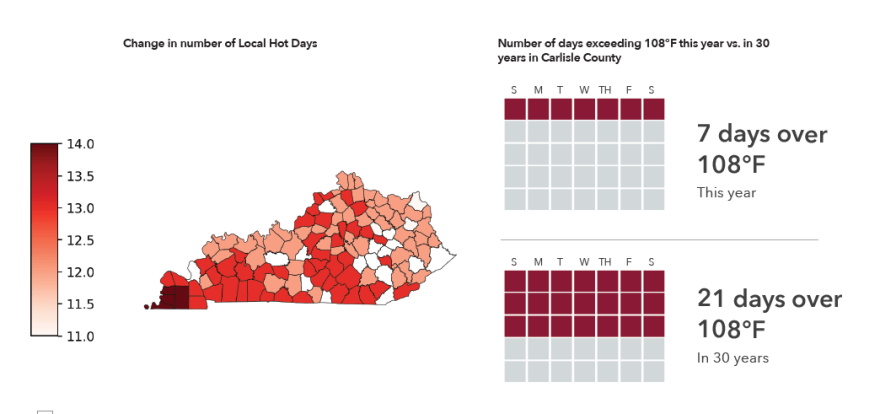Parts of Kentucky are likely to face days when the heat index reaches 125 degrees or more over the next three decades.
A new study from the climate nonprofit research group First Street Foundation finds that Kentucky is likely to become part of an “extreme heat belt” concentrated in the middle of the country.
The report highlights how different regions are expected to be impacted by extreme heat: from rising CO2 emissions related to air-conditioning use, to the states that will face the most consecutive days of extreme heat.
“The increase in extreme heat conditions are a cause for concern, impacting everything from personal health to electricity costs associated with increased air conditioning usage, to physical infrastructure, and even public transport,” the report states.
Researchers say the extreme heat belt stretches from the northern border of Texas through Iowa, Indiana, Kentucky and up into Wisconsin. Much of the region is far from coastal breezes, in areas where humidity will bolster high temperatures to make the heat feel even more oppressive.
This area, more than any other, is expected to see the largest increases in dangerous heat.
The study found this region is at the greatest risk for heat-related illnesses, with heat indexes capable of reaching 125 degrees or more in the next 30 years — the length of a typical U.S. mortgage.
First Street Foundation analyzed surface temperatures, tree cover, impervious surfaces like asphalt and proximity to water to measure heat exposure across the country.

Extreme heat is already the No. 1 cause of weather-related deaths in the United States.
Researchers say parts of Kentucky are likely to see a 200 percent increase in local hot days over the next 30 years:
- Louisville is likely to see 21 days with a heat index over 105 degrees.
- The western Kentucky counties of Carlisle, Hickman and Fulton could see 21 days with a heat index over 108 degrees — the worst in the state.
Greenhouse gasses from burning fossil fuels have already warmed the planet around 2 degrees since the dawn of the industrial age, with most of the warming occurring since 1975, according to NASA.
Temperatures are expected to continue to rise at least 2.5 degrees over the next three decades, according to the Fourth National Climate Assessment.
Extreme heat brings with it a host of other problems: Hot, sunny days increase the odds of ground-level ozone forming and worsening air quality. A warmer atmosphere also holds more moisture, increasing humidity and the odds for extreme weather, including floods and droughts.
Climate scientists with the Intergovernmental Panel on Climate change warn the world must end its reliance on fossil fuels as soon as possible in order to avoid the worst impacts of climate change.



